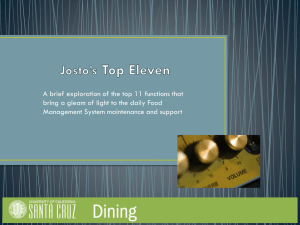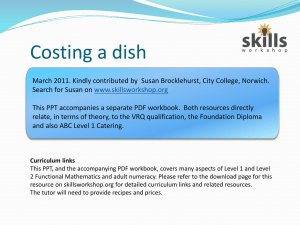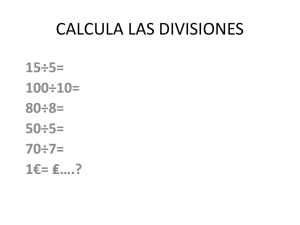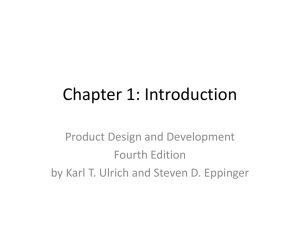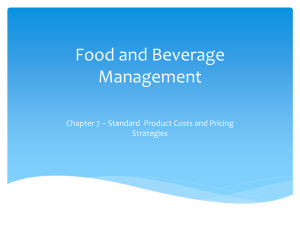DUTIES AND RESPONSIBILITIES (cont`d)
advertisement
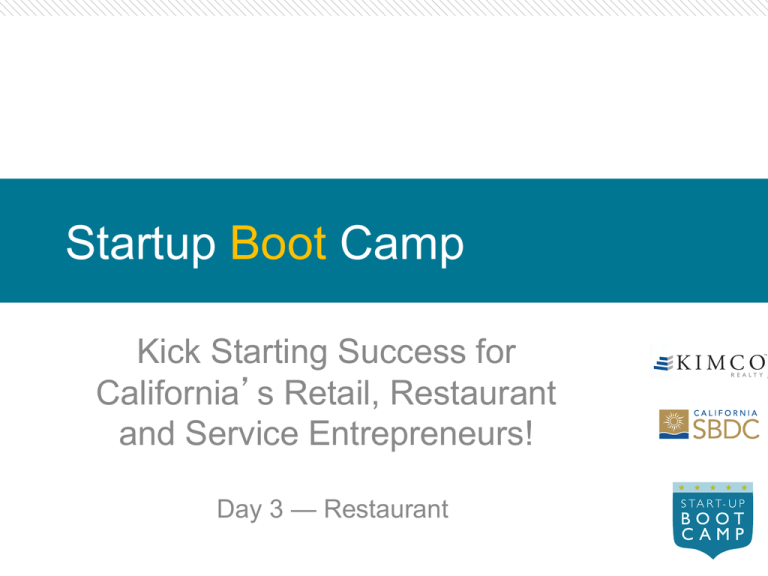
Startup Boot Camp Kick Starting Success for California’s Retail, Restaurant and Service Entrepreneurs! Day 3 — Restaurant RESTAURANT BASICS Goals/Expectations Concept development Marketing and vetting the concept Business planning Operations Financials – ANALYZE YOUR COSTS Legalities Triple bottom line Customers and social media Tools and resources 3 Know Your Concept It’s all about the market Visit the competition Find resources Choose a practice Know who your team is Be realistic 4 Know Your Market Price, Product, Promotion, Placement Research everything under the sun Arm yourself with knowledge What are you selling? What are industry trends? Do you need to adapt your concept to fit the market? Engage and Educate. Be outgoing Do you want to start with a catering business or food cart? Here’s an example of resources for a mobile food businesses: http://www.sfcartproject.com/ 5 Connect To Your Market Focus on: research, branding, positioning, culture, public relations, training, design, local store marketing, new store openings, concept development and restaurant growth strategy. Build relationships with employees and guests….They are two of your company’s best assets. “Market between Your Four Walls.” Once you start to sell in any capacity remember to increase check averages, increase party size and implement local store marketing. Form and build partnerships through: Visitor councils, Chambers of Commerce, networking groups, non-profits, vendors, sports teams, local festivals and events, community and professional organizations, officials, schools and churches. 6 Business Planning You don’t build a house without architectural plans. Who, what, where, why and how…or: − Market, operations and financials. Adapt your concept for your operation? Financial spreadsheets - forecasting, tracking, saving Analyze costs before you price your menu Know your competitors prices but don’t base yours on theirs Here are two great resources: − http://www.allfoodbusiness.com/starting_your_own_business.php − http://www.bplans.com/fast_food_restaurant_business_plan/executive_summary_f c.php#.UGndv0TGI7t 7 Benefits Of A Business Plan: Support a loan application Raise equity funding Define and fix objectives and programs to achieve those objectives Create regular business review and course correction Define a new business Define agreements between partners Set a value on a business for sale or legal purposes Evaluate a new product line, promotion, or expansion 8 Personnel Relationships Job Descriptions Protocol of Hiring/Separation Follow-through, incentives Training Retention Open and Honest Communication Team Development 9 Sample Job Description: Exec. Chef SUMMARY This is administrative and supervisory work involving the development of recipes and menus in a major food establishment. This position requires a higher skill level and longer work hours than the Chef in the meal plan area. Work involves the supervision of special events preparation in accordance with recipes and menus. Work requires training employees on the retail side and preparation and inventory control. Activities and decisions are varied in nature, requiring the solving of both common and unusual problems. Direction is received from an administrative superior on matters pertaining to special menus and operating policies. 10 Sample Job Description (cont’d) DUTIES AND RESPONSIBILITIES Develops recipes and menus for all retail food operations Supervises food production Maintains food cost standards and cost Promotes safety and proper sanitation Assists in taking inventory and purchasing supplies Introduces new products Acts as replacement worker when short staffed Handles customers' concerns and suggestions 11 Sample Job Description (cont’d) DUTIES AND RESPONSIBILITIES (cont’d) Handles employees' concerns and issues. Controls food waste by using in proper areas to be distributed daily. May have full or final responsibility for job actions (e.g., new hires, promotions, demotions, transfers, discipline, terminations). Schedules/assigns work. Sets production goals or job expectations. Trains, coaches or counsels, directs/coordinates. Asses performance and completes a formal performance evaluation. Participates in determination of salary and salary changes. Other duties as necessary. 12 Sample Job Description (cont’d) KNOWLEDGE, SKILLS AND ABILITIES Have a thorough knowledge of the materials, methods, and equipment used in preparing food on a large scale. Have considerable knowledge of food preparation and food service management, methods, and techniques. Able to work long hours. Considerable knowledge of food values, nutrition, and menu planning costs, and uses for leftover food. Able to plan and modify menus to meet various requirements. Able to control and manage retail food service operations. Able to take inventory and keep records of foods used. 13 Sample Job Description Cont. KNOWLEDGE, SKILLS AND ABILITIES (cont’d) Must have considerable knowledge of health hazards in food preparation and service, and of necessary precautionary measures. Able to supervise the work of others. Able to prepare working schedules for employees and to instruct subordinates in food service procedures. Must be able to maintain a variety of records and to prepare reports. EDUCATION AND EXPERIENCE Bachelor's Degree and a minimum of 4 years experience or an Associate Culinary Degree; Sanitation Certification; Driver's License 14 Work/Life Balance Continue to define your values What are the reasons you are a restaurant owner? Do you know your expenses, your family, your employees? Your WORTH? Can you adjust your attitude, coaching, or systems to grow yourself? How adaptable are you? Do you have a goal? Do you take vacations? Do you breathe…A LOT? 15 Financial Acumen This is THE piece that will make your business die or thrive so know it inside and out Draft financial spreadsheet and amend as much as you can: − − − − − − − Start-up capital Weekly Labor Projections Weekly Food Costs Weekly Overhead Costs Daily/weekly Sales Target Profit and Loss (Years 1-3) Cash Flow Statements (Years 1-3) Save your receipts Reconcile your books as often as you need to stay organized Hire a bookkeeper or tax accountant if those aren’t within your skill set 16 Financials Cost analysis Detailed statements – – – – – – List of equipment and expenses – COGS Income Statement – snapshot of time Profit and Loss Pro-forma – remember they’re just projections Generate sales goals POS 17 Food Cost Spreadsheet Plate Costing Calculator #1 General Information Item Date #2 Enter Recipe Data Yield 16 Recipe Quantity Ingredients Unit/LB/OZ Procedure Unit Cost Purchase Unit % Yield Conversion Actual Unit Cost Extension Oz. $ - LB $ - $ - $ - $ - Oz. $ - Oz. $ - Oz. $ - Oz. $ - Oz. $ - LB $ - $ - $ - $ - $ - $ - $ - $ - $ - $ - $ - $ - - $ - $ - - $ - $ - $ - $ - Total Cost of Item $ - Cost per Serving $ - Total Cost of Recipe Waste (10%) 10% #3 Plate Costing & Menu Pricing Cost Per Serving $ - $ - Plate Cost Calculation Portion Cost of This Recipe Target Food Cost 23.0% Menu Price at Target $ - Current Menu Price $ 3.25 0.0% Current Food Cost Condiment: Portion Cost $ - Side Dish: Portion Cost $ - $ - Cover Cost Total Plate Cost Mark Up Per Plate $ - Cost Plus Plate Cost $ - Gross Margin Markup 100.0% #DIV/0! 18 Cash Flow Analysis 19 Access To Capital Typical loans are difficult to attain for food businesses. Most investors want to see a significant growth rate. Ask friends and family with money. Set terms and PAY THEM BACK. Boot strap. Remember that there’s always a way. Plan properly, take risks, be brave, sell with confidence. 20 Taxes Know how much money to save and SAVE IT…if you don’t it can be detrimental Taxes – better to pay consistently Hire or at least speak to an accountant and/or bookkeeper Visit www.irs.gov, www.sba.gov for more information 21 Opening Your Restaurant Set Realistic Goals. Timelines, costs, course of action, etc. Know what is needed in your kitchen to succeed. Understand the working hours. Always know your costs. Enjoy it! Go here for downloadable version: http://www.foodserviceresource.com/PreOpeningChecklist.html 22 Customers And Social Media Always keep the focus on your people, they are your company. Use social media to create a following. Regular updates allow you to control information, reinforce brand recognition and encourage conversation. Encourage your employees to take an interest in the whole business, not just their individual part…create a real team effort. Marketing and sales should emphasize your employees too, not just your product. When morale is high and employees care about the business, sales will increase. They are your best sales asset! 23 All About The Food It’s all about the food - consistency, price, taste, quality.. Use portion control to maintain consistency and costs. Tend to safety and sanitation principals and guidelines. Check out Food Safety sites for your county and state: http://www.foodsafety.gov/. Create a recipe book to help analyze costs, train staff and produce a consistent product. ALWAYS make sure it tastes good. Make sure your chefs taste the food. Don’t raise your prices unless you absolutely have to. Let the customers tell you what the best thing ever is. 24 Trends and Innovative Ideas Explore a triple-bottom-line concept - an important set of values and criteria for measuring organizational and societal success: economic, ecological and social Environmental impact especially as it relates to $. Buy local and seasonal – better quality, price and supports local economy. Waste management practices – compost, recycling. Product utilization. Community involvement - as it pertains to cross-marketing, great PR and lasting partnerships. Consider future generations. 25 It’s All What You Make It Understand your ingredients, who you source from. Be picky! Finish your business plan. Revisit semi-annually. Have a financial cushion. PAY YOURSELF. Recommend a minimum of 12-24 months of savings. Adapt to your market. Always be willing to adjust your vision. It’s never what you think. Self-evaluate to ensure you are maintaining your core vision. Stay Positive! 26 Internal $ Saving Strategies Recipe and Menu Pricing – Have you done this and do you have recipes and costs for each dish that you adhere to? Recipe books - Consistency with Product All products are tracked with portion control and waste logs Use local and seasonal food and vendors Retaining staff 27 Staying Current Have your pulse on trends and innovative ideas Subscribe to industry magazines and read blogs, books and tweets Get out in the field at least one day a week and talk to customers and potential customers; network. Don’t be afraid to make change while keeping brand integrity Volunteer, good things can come from it 28 Systems – Create/Use Them Financial spreadsheets, bookkeeping Personnel procedures/protocol - prep and clean-up lists Customer and marketing tracking POS - food costing, inventory management, profit & loss, cash flow, payroll 29 Resources Add in web site or www.asbdc.org Taxes: www.irsvideos.gov/virtualworkshop/ Governor's Office of Business and Economic Development http://business.ca.gov/StartaBusiness.aspx Permits and licenses - www.calgold.ca.gov One listing of useful resources -http://www.lacocinasf.org/resources/ 30
